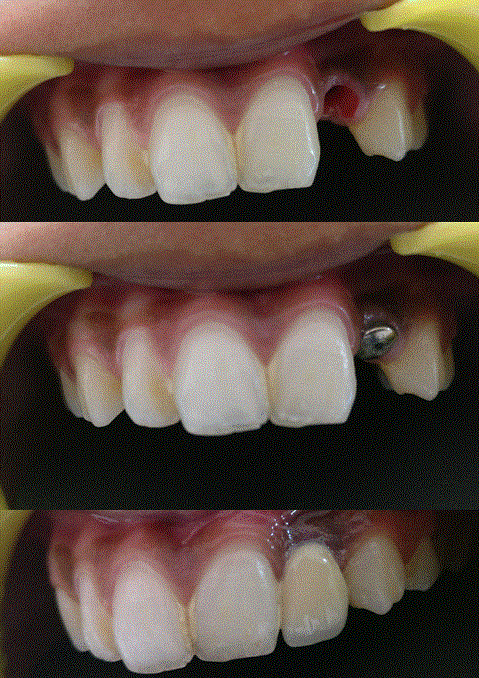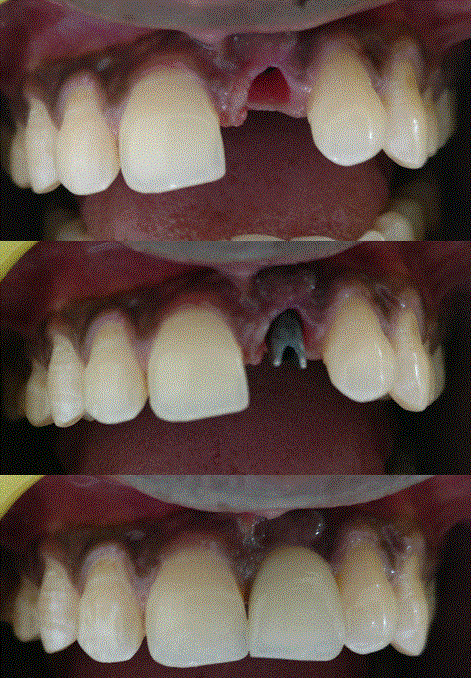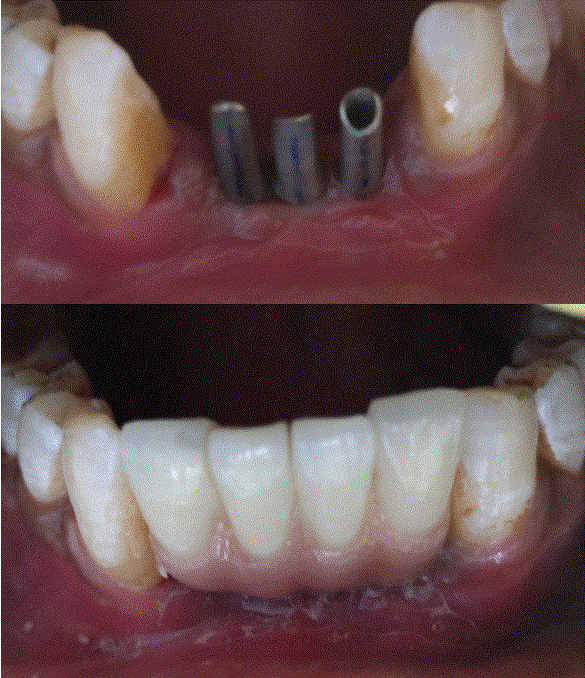Treatment: Implants
Implants
Implants are metallic screws or posts which are inserted in the jaw bones and act like artificial roots that support artificial teeth (crowns or bridge) or dentures.
Implants are made of Titanium which is a body-friendly metal.
Implants are inserted surgically in the jaws, in the region of the tooth/teeth to be replaced. Implants are later fitted with a small part called abutment on which the final crown or bridge is placed.

Our team of Dr.Atul Kulkarni and Dr.Nivedita Kulkarni is an expert performer that you can rely on.
Why implant?
Implants have many advantages over traditional bridge for replacing lost teeth.
- Bridge needs cutting of adjacent teeth to accommodate the crowns. Implant supports the crown avoiding the modification of any natural teeth.
- Implants distribute the load to the bone, which stabilizes the bone level. There shall be a certain amount loss of bone otherwise.
- Replacement of teeth in perfect manner improves chewing and thus general health. It also restores facial form and beauty.

Missing upper right central incisor tooth

Implant inserted with the cover screw exposed

Crown cemented over the abutment

Upper Anterior Implants
Who can have dental implants?
The ideal candidate for a dental implant is in good general and oral health. Adequate and good quality-bone in your jaw is needed to support the implant, and the best candidates have healthy gum tissues that are free of periodontal disease.
Dental Implants are indicated as a treatment option for:
- Replacing a Single Tooth: If you are missing a single tooth, one implant and a crown can replace it. A dental implant replaces both the lost natural tooth and its root.
- Replacing Several Teeth: If several teeth are lost, implant-supported bridges can replace them. Dental implants will replace both your lost natural teeth and some of the roots.
- Replacing All of Your Teeth: If you have lost all of your teeth, an implant-supported full bridge or full denture can replace them. Dental implants will replace both your lost natural teeth and some of the roots
Who should not have Dental Implants?
- Patients suffering from crippling or uncontrolled diseases such as uncontrolled diabetes, leukemia, hyperparathyroidism etc.
- Patients undergoing chemotherapy and radiotherapy.
- Women in their 1st three months of pregnancy.
- Patients who are unable to maintain good oral hygiene for certain reasons.
Before Placing an Implant
Before a dental implant is placed, you may need to have the bone in the area built up to increase the chance of success. This is a common procedure called bone grafting or augmentation. You may have the bone graft done and get the implants at the same time, but your dental specialist may decide to do the bone-graft procedure first and give the bone time to heal before placing the implants. If the bone graft is done first, you will need 4 to 12 months to heal before having the implants placed in your jawbone. However, you can wear your dentures or bridge during this time, so you won’t be without teeth.
Placing the Implants
Most implants are placed using a two-step process, although some newer implants can be placed in one step.
The First Step – Insertion of the implant
The procedure is carried out under local anesthesia.
To place the implants, we first will make an incision (cut) in your gums to expose the bone. We then will drill a hole in the bone for the implant, and place the implant in the hole. We may take an X-ray of the area to make sure the implant is where it should be and then stitch (suture) your gum closed over the implant. The time required for this procedure depends on the number of implants being placed and whether or not bone grafting is being done at the same time. In most cases, placing a single dental implant requires about one hour. You will be advised to take some medicines thereafter.
If the implant is placed in the front of your mouth, We will give you a temporary denture or bridge so that you do not have to be without teeth. We will discuss options with you before the surgery.
After your surgery you may be advised the following
- Don’t spit, suck on straws or smoke. This can dislodge blood clots and slow healing.
- Eat only soft food to avoid injuring your gum tissues.
- Don’t try to clean the implant area for the next one to two weeks, but clean the rest of your mouth normally. Your dentist may give you an antibacterial rinse to help keep the area clean.
- You will be advised to return to us after 7 to 10 days to have your stitches removed.
- After the implant is placed in your jaw, you will have to wait for 2-3 months for the bone to bond with the implant. During this time, the head of the implant usually remains hidden under your gum. In case of immediate loading, the implant is not covered at all. The crown is prepared and restored within 10 days after implant placement.
The Second Step
After the implants have integrated (attached) with the surrounding bone, you are ready for the second surgery. After giving local anesthesia, we will make a small incision in the gum to expose the implant. In case of immediate loading implants, this step is performed within 10 days of the first step. The protective screw will be removed from the implant and will be replaced with an abutment. After the impression (measurement) of the abutment, the final crown is prepared and ic cemented above the abutment.
In a very small percentage of cases, the implants will not have successfully bonded with the bone. If this happens, We may either remove the implants and immediately replace them with slightly wider ones, or remove them and allow the area to heal for several months before making a second attempt.
Tooth in a day
We have been doing immediate implant and crown in selected situations. This is carried out at the time of tooth extraction or when a patient needs a tooth for cosmetic reasons immediately. There are however limitations for this technique. In a selected patient undergoing a tooth extraction, the implant placement planning is completed beforehand. The implant is placed immediately after the tooth is extracted and the crown is placed within few hours. This crown is changed later if required.
Complications from Surgery
Any surgery carries the possibility of complications. Complications of implant surgery include bleeding, infection and injury to nerves, sinuses (located above your upper teeth) or nasal cavity.
Implant Failure
Implant surgery is successful more than 97% of the time. Occasionally, an implant fails to bond with the surrounding bone. This is usually discovered at the second stage surgery when the implant is uncovered and is loose. In this case, the “failed” implant has to be removed. Another implant can be placed either immediately or at a later visit.
Potential reasons for implants failing to integrate with surrounding bone include:
- Surgical trauma
- Infection around the implant
- Smoking — This appears to decrease blood flow to the healing gums and bone, which could interfere with the bonding process.
- Lack of healthy bone — If there is not enough bone for the implant to remain stable, the implant may move around within the bone and bonding will not occur.
- Titanium allergies — These are extremely rare.



